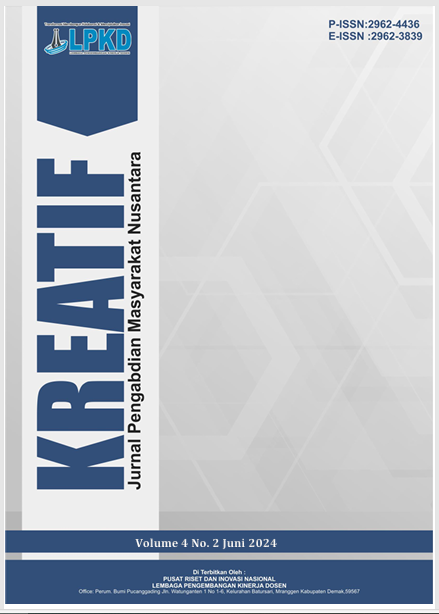Edukasi Dan Skrining Diabetes Mellitus Tipe 2 Melalui Pemeriksaan HbA1c Pada Kelompok Lanjut Usia
DOI:
https://doi.org/10.55606/kreatif.v4i2.3404Keywords:
Type 2 diabetes mellitus, HbA1c, glycemic control, elderlyAbstract
Type 2 diabetes mellitus is a chronic disease characterized by high blood glucose levels due to insulin resistance or inadequate insulin production. In the elderly, diabetes mellitus causes various serious complications such as heart disease, nerve damage, kidney failure and vision problems. Risk factors for diabetes mellitus include family history, obesity, lack of physical activity, a diet high in fat and sugar, and hypertension. This community service activity aims to increase awareness and early detection of type 2 diabetes mellitus through education and HbA1c screening in the elderly. Of the 93 lanjut usiats, 74 were women and 19 were men, with an average age of 74.05 years. The mean HbA1c value was 7.59, with 55.9% in the moderate category and 25.8% in the poor category. Results showed that suboptimal glycemic control was higher in women. This program highlights the need for regular monitoring and appropriate interventions to improve glycemic control and quality of life for older adults through comprehensive education, physical activity and stress management.
References
Arifin, B., et al. (2019). “Diabetes Distress in Indonesian Patients with Type 2 Diabetes: A Comparison between Primary and Tertiary Care.” BMC Health Services Research 19(1) (December): 773. https://doi.org/10.1186/s12913-019-4515-1.
Baroto, R. T., et al. (2023). “Profil Demografik, Hematologi, Serta Gula Darah Sewaktu Pasien Ulkus Diabetik Pro Amputasi.” MAHESA: Malahayati Health Student Journal 3(10): 3346–54.
Bhattacharjee., et al. (2023). “High Risk Genetic Variants of Human Insulin Receptor Substrate 1(IRS1) Infer Structural Instability and Functional Interference.” Journal of Biomolecular Structure & Dynamics 41(24): 15150–64. https://doi.org/10.1080/07391102.2023.2187232.
Chentli, F., Azzoug, S., and Mahgoun, S. (2015). “Diabetes Mellitus in Elderly.” Indian Journal of Endocrinology and Metabolism 19(6): 744. https://doi.org/10.4103/2230-8210.167553.
Destra., Edwin., and Firmansyah, Y. (2022). “Intervention Program in Effort to Reduce New Cases.” Jurnal Pengabdian Mandiri 1(5) : 677–82.
Gan, L., et al (2011). “Mechanisms and Implications of Age-Related Changes in the Liver: Nonalcoholic Fatty Liver Disease in the Elderly.” Current Gerontology and Geriatrics Research 2011: 1–12. https://doi.org/10.1155/2011/831536.
Gómez-Huelgas, R., et al. 2018. “Treatment of Type 2 Diabetes Mellitus in Elderly Patients.” Revista Clínica Española (English Edition) March, 218(2): 74–88. https://doi.org/10.1016/j.rceng.2017.12.004.
Hendrawan, S., et al. (2023). “Kegiatan Pengabdian Masyarakat Dalam Rangka Peningkatan Kewaspadaan Masyarakat Terhadap Penyakit Pre-Diabetes Dan Diabetes Mellitus Tipe II Dengan Edukasi Dan Deteksi Dini Penyakit.” Jurnal Pengabdian Ilmu Kesehatan 3: 36–49. https://doi.org/https://doi.org/10.55606/jpikes.v3i2.1808.
Khan., at el., (2019). “From Pre-Diabetes to Diabetes: Diagnosis, Treatments and Translational Research.” Medicina (Lithuania) 55(9): 1–30. https://doi.org/10.3390/medicina55090546.
Kulozik., Felix., and Hasslacher, C. (2013). “Insulin Requirements in Patients with Diabetes and Declining Kidney Function: Differences between Insulin Analogues and Human Insulin?” Therapeutic Advances in Endocrinology and Metabolism August, 4(4): 113-21. https://doi.org/10.1177/2042018813501188.
Li, Z., et al. (2022). “Mutations in GCK May Lead to MODY2 by Reducing Glycogen Synthesis.” Advanced Biology 6(11) (November): e2200097. https://doi.org/10.1002/adbi.202200097.
Lopez-Jaramillo., et al. (2023). “Association of the Triglyceride Glucose Index as a Measure of Insulin Resistance with Mortality and Cardiovascular Disease in Populations from Five Continents (PURE Study): A Prospective Cohort Study.” The Lancet Healthy Longevity 4(1): e23-33. https://doi.org/10.1016/S2666-7568(22)00247-1.
Luo., et al. (2021). “Prognostic Significance of Triglyceride-Glucose Index for Adverse Cardiovascular Events in Patients With Coronary Artery Disease: A Systematic Review and Meta-Analysis.” Frontiers in Cardiovascular Medicine December, 8: 1–10. https://doi.org/10.3389/fcvm.2021.774781.
Nistiandani, A., et al. (2020). “Characteristic Of Demographic Neuropathy Diabetic Perifer In The Agriculture Area.” Jurnal Ners Dan Kebidanan Indonesia April, 7(3): 192. https://doi.org/10.21927/jnki.2019.7(3).192-202.
Phu, S., et al. (2023). “Single Nucleotide Polymorphism at Rs7903146 of Transcription Factor 7-like 2 Gene Among Subjects with Type 2 Diabetes Mellitus in Myanmar.” Journal of the ASEAN Federation of Endocrine Societies 38, no. 1: 41-47. https://doi.org/10.15605/jafes.037.S2.
Santoso, A. H., et al. (2023). “Community Service Activities -Counseling And Random Blood Sugar Screening (Type 2 Diabetes Mellitus).” Cakrawala: Jurnal Pengabdian Masyarakat Global 2: 110–18. https://doi.org/10.30640.
Sinha, S., and Haque, M. (2022). “Insulin Resistance Is Cheerfully Hitched with Hypertension.” Life 12(4): 1–17. https://doi.org/10.3390/life12040564.
Soelistijo, S. A., et al. (2019). “Pengelolaan Dan Pencegahan Diabetes Melitus Tipe 2 Dewasa Di Indonesia.” PB Perkeni, 133.
Tabák, A. G., et al. (2012). “Prediabetes: A High-Risk State for Diabetes Development.” Lancet (London, England) June 379(9833): 2279-90. https://doi.org/10.1016/S0140-6736(12)60283-9.
Tan, S. T., et al. (2023). “Effectiveness of Secretome from Human Umbilical Cord Mesenchymal Stem Cells in Gel (10% SM-HUCMSC Gel) for Chronic Wounds (Diabetic and Trophic Ulcer) – Phase 2 Clinical Trial.” Journal of Multidisciplinary Healthcare 16, no. June (June): 1763–77. https://doi.org/10.2147/JMDH.S408162.
Tilinca, M. C., et al. (2021). “A 2021 Update on the Use of Liraglutide in the Modern Treatment of ‘Diabesity’: A Narrative Review.” Medicina June 57(7): 669. https://doi.org/10.3390/medicina57070669.
Wijayatri, R., Kurniasari, K., and Ulya, L. F. (2022). “Pengaruh Kolaborasi Gizi Dan Farmasi Terhadap Tingkat Pengetahuan Diabetes Mellitus Lansia.” INPHARNMED Journal (Indonesian Pharmacy and Natural Medicine Journal) January 5(2): 43. https://doi.org/10.21927/inpharnmed.v5i2.1924.
Zeyfang, A., Wernecke, J., and Bahrmann, A. (2023). “Diabetes Mellitus at an Elderly Age.” Experimental and Clinical Endocrinology & Diabetes February 131(01/02): 24–32. https://doi.org/10.1055/a-1946-3728.
Downloads
Published
How to Cite
Issue
Section
License
Copyright (c) 2024 Robert Kosasih, Daniel Goh, Tosya Putri Alifia

This work is licensed under a Creative Commons Attribution-ShareAlike 4.0 International License.








